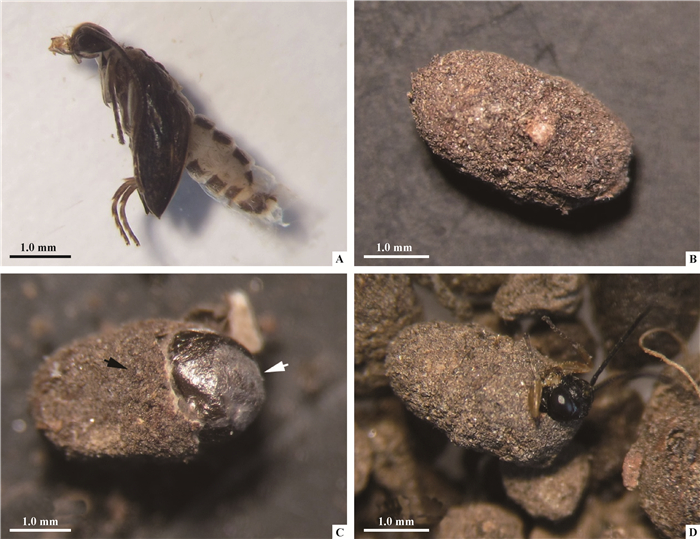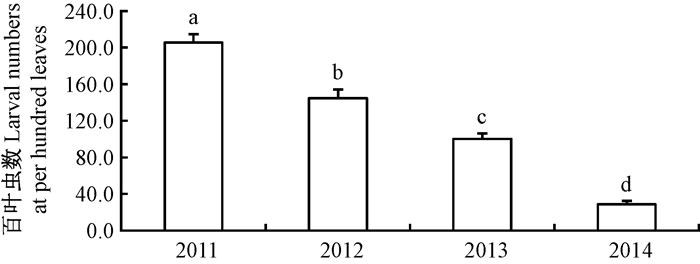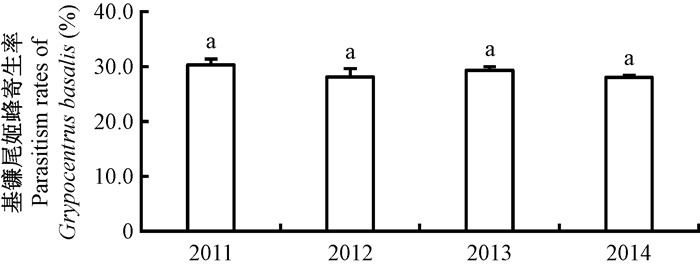文章信息
- 李涛, 曾汉青, 盛茂领, 才让旦周, 周卫芬, 孙淑萍
- Li Tao, Zeng Hanqing, Sheng Maoling, Cairang danzhou, Zhou Weifen, Sun Shuping
- 危害桦树的重要害虫--高山毛顶蛾(鳞翅目:毛顶蛾科)生物学特性及寄生性天敌昆虫
- Biological Characteristics of Eriocrania semipurpurella alpina (Lepidoptera: Eriocraniidae) and Its Natural Enemy Parasitoids
- 林业科学, 2016, 52(10): 102-108
- Scientia Silvae Sinicae, 2016, 52(10): 102-108.
- DOI: 10.11707/j.1001-7488.20161013
-
文章历史
- 收稿日期:2014-12-30
- 修回日期:2015-10-15
-
作者相关文章
2. 青海省互助县森林病虫害防治检疫站 互助 810500;
3. 青海省森林病虫害防治检疫总站 西宁 810008
2. Huzhu Forestry Pest Control and Quarantine Station Huzhu 810500 ;
3. Qinghai Forestry Pest Control and Quarantine Station Xining 810008
毛顶蛾科(Eriocraniidae)是鳞翅目(Lepidoptera)较原始的科,该科昆虫分布于古北区,包括5属,约30种(Kristensen, 1999; van Nieukerken et al., 2011),日本分布4种(Mizukawa et al., 2004)。我国已报道分布2种及1亚种:洒金毛顶蛾(Eriocrania sparrmannella)、拟紫毛顶蛾(E. semipurprella Stephen)和高山毛顶蛾(E. semipurprella alpina)(杨集昆, 1977; 徐振国等, 1990)。
高山毛顶蛾分布于青海海东地区,主要危害白桦(Betula platyphylla),部分危害红桦(B. albo-sinensis)、糙皮桦(B. utilis)(徐振国等,1990;萧刚柔,1992;张增来等,2011)。2004年在青海省互助县北山林场巴扎营林区,首次发现该虫危害白桦,2005年发生面积逐步扩大。2006-2009年,该虫在北山林场暴发成灾,白桦叶片受害率几乎为100%,红桦受害率为78%,糙皮桦受害率为35%(张增来等, 2011)。
徐振国等(1990)对高山毛顶蛾成虫形态特征进行了详细描述,在对其生物学特性观察过程中,报道该虫2年1代,老熟幼虫离叶后,沿枝干下行,在树冠周围腐殖质层结茧越冬;而关于幼虫各龄期形态特征等未见报道。张增来等(2011)对该虫发生规律及防治技术进行了初步研究。据报道(盛茂领等, 2014; Heath, 1961; Jordan, 1998a; 1998b; Yu et al., 2012),镰尾姬蜂属(Grypocentrus)的种类是毛顶蛾(Eriocrania spp.)的主要寄生天敌类群。才让旦周等(2013)报道了寄生高山毛顶蛾越冬茧的姬蜂科中国1新记录种--基镰尾姬蜂(Grypocentrus basalis Ruthe, 1855),并对其形态特征进行了详细描述。高山毛顶蛾成虫羽化期较早,4月底开始羽化,羽化不整齐,成虫期较长,且产卵于叶肉,幼虫潜叶危害,采用药剂防治效果不佳,且易大量杀死天敌。因此,对高山毛顶蛾生物学特性及寄生性天敌昆虫的详细研究,有助于高山毛顶蛾的综合防治。
1 材料与方法 1.1 试验地概况互助北山林区位于青海省互助县东北部,处于黄河二级支流大通河中下游,介于达坂山与冷龙岭之间,是重要的水源涵养林区之一,森林覆盖率68%。林区桦树林面积10 000 hm2,高山毛顶蛾发生面积4 056 hm2,重度发生面积1 927 hm2(陈文俊,2011)。
试验点选在北山林场甘冲沟地区(37°01′N,102°21′E,海拔2 400~2 500 m),林区主要以白桦为主,有少量红桦、糙皮桦和祁连圆柏(Juniperus przewalskii)。
1.2 生物学观察越冬茧虫口密度调查采用野外随机抽取样方法,调查不同土层深度的越冬茧数量。将采集的越冬茧带回室内,观察羽化情况,记录成虫和寄生性天敌每天的羽化情况。待毛顶蛾成虫羽化结束后,对剩余越冬茧进行解剖,统计羽化和天敌寄生情况。
成虫发生期,在试验点进行成虫习性及产卵情况观察:1)采用叶片标记的方法,对毛顶蛾卵进行标记,并记录卵孵化及幼虫发育情况;2)采集标记叶片,用显微镜(Zeiss STEMI SV8体视显微镜)观察和测量各龄期幼虫的发育情况。
幼虫危害期,野外随机抽取危害枝条,调查百叶虫口密度。老熟幼虫期,每天观察老熟幼虫脱叶下树情况,统计下树日高峰期。
1.3 统计分析在单因素方差分析0.05水平下,进行检验[Ryan-Einot-Gabriel-Welsh (REGW) Q测验,SPSS 17.0]。
2 结果与分析 2.1 形态特征 2.1.1 成虫见文献(徐振国等, 1990)(图 1A)。

|
图 1 高山毛顶蛾 Fig.1 E. semipurpurella alpine A.雌虫产卵Female of E. semipurpurella alpina laying egg under the leaf epidermis; B.卵(箭头示),插入图示发育中的卵(图上标尺不包括插入图,下同)Egg (arrow), inset shows a developing egg (Scale bar not including inset photo, the same below);C. 1龄幼虫First instar larva;D. 2龄幼虫及蛀道,1龄幼虫头壳(箭头示),2龄幼虫前胸背板(插入图)Second instar larva, head capsule of the 1st instar larva (arrow), inset shows the protergum of the 2nd instar larva;E. 3龄幼虫Third instar larva;F. 4龄幼虫,从叶片钻出即将下树,4龄幼虫前胸背板(插入图)Fourth instar larva came out from the leaf, inset shows the protergum of the 4th instar larva. |
椭圆形,长约为0.35~0.4 mm,宽约为0.20~0.25 mm,初产时翠绿色,后呈乳白色。卵单产于桦树嫩芽或初展新叶背面,产卵后叶片下表皮稍隆起,肉眼可明显看到卵的形状(图 1B)。幼虫孵化后,卵壳变成黄褐色,干瘪。
2.1.3 幼虫属于全头无足型幼虫。通过对毛顶蛾幼虫头壳宽度统计分析,头壳宽度之间差异显著(F=1 298.57, df=3, 106, P < 0.001)(表 1)。1龄幼虫,体长0.7~1.7 mm,乳白色;头壳黑褐色,头壳宽0.20~0.27 mm,平均宽0.24 mm(图 1C)。2龄幼虫,体长1.8~3.0 mm;头褐色稍带红色,头壳宽0.31~0.38 mm,平均宽0.35 mm;前胸背板和腹板具黑褐色斑纹,斑纹大小几乎同背板(图 1D,插入图);体表具褐色小瘤点;幼虫体稍呈绿色(图 1D)。3龄幼虫,体长3.6~5.5 mm;头褐色稍带红色,头壳宽0.37~0.48 mm,平均宽0.45 mm,头部约一半缩入前胸;前胸背板和腹板中间具白色条带,致使黑褐色斑纹呈不规则条带状,其他特征同2龄幼虫(图 1E)。4龄幼虫,体长7.5~9.0 mm,乳白色(图 1F);头红褐色,头壳宽0.61~0.70 mm,平均宽0.65 mm,一半缩入前胸,前胸背板无斑纹(图 1F,插入图)。
|
|
蛹为强颚离蛹。体黑褐色,长约为4.0~4.5 mm,具强大上颚,腹部黄白色,具褐色短毛(图 2A)。

|
图 2 高山毛顶蛾及寄生性天敌 Fig.2 E. semipurpurella alpine and its parasitoid A.蛹Pupa;B.越冬茧Overwintering cocoon;C.高山毛顶蛾越冬茧(黑色箭头),基镰尾姬蜂茧(白色箭头)Cocoon of E. semipurpurella alpine (black arrow), cocoon of Grypocentrus basalis (white arrow);D.基镰尾姬蜂成虫Adult of Grypocentrus basalis. |
长椭圆形,长约为3.4~3.8 mm,宽约为1.8~2.0 mm,包被细小土粒(图 2B)。
2.2 生物学特性 2.2.1 生活史青海互助,该虫1年1代,以老熟幼虫下树结茧越冬(表 2)。越冬老熟幼虫翌年4月中旬开始化蛹,4月下旬为化蛹高峰期,5月中旬化蛹结束。高山毛顶蛾成虫羽化(图 3):4月下旬始见成虫,5月上、中旬为成虫羽化高峰期(2012年,5月4日为成虫羽化高峰),5月下旬成虫羽化结束。卵期为7~10天。5月下旬-7月上旬为幼虫危害期;老熟幼虫6月下旬开始陆续从叶片中钻出,在叶片正面或边缘开一脱落孔,直接坠入树冠周围腐殖质层(图 1F)。老熟幼虫每天下树高峰集中于12:00-15:00;晴朗午后,老熟幼虫下树数量较多,阴雨天很少下树(图 4)。下树老熟幼虫在腐殖质层下土层0~12 cm处结茧化蛹,不同土层深度越冬茧数量差异显著(F=61.05, df=4, 35, P < 0.001),3~9 cm深度的数量较多,3~6 cm深度最多(图 5)。入土7~10天吐丝结密实茧,茧内老熟幼虫呈“C”形弯曲。越冬幼虫于翌年4月中旬开始化蛹,蛹期约8~14天。

|
图 3 高山毛顶蛾成虫羽化趋势(2012年) Fig.3 Emerging date of E. semipurpurella alpina adults in 2012 |

|
图 4 老熟幼虫下树时间 Fig.4 Time of the last-instar larva dropped to ground from leaves |

|
图 5 不同土层深度高山毛顶蛾越冬茧数量(2011) Fig.5 Numbers (+ SE, n=40) of E. semipurpurella alpina cocoon in different soil depth |
|
|
高山毛顶蛾成虫白天活动,常停息于树干和叶片上,以树干上较多。成虫具有假死性,受到干扰后,从树干或叶片上直接坠地,片刻后找合适场所隐蔽。成虫交尾多在树干上进行,交尾时间20~40 min。交尾后,于叶片背面雌虫即“可产卵”。产卵前,雌虫用触角在叶面上搜寻适宜的产卵点,找到后立即将产卵器刺入表皮(图 1A)。卵单产于叶片背面表皮下,产卵时间2~20 min不等,多数约10 min。卵期7~10天。1龄幼虫孵化后,在叶肉中形成细长或弯曲的蛀道,其排泄物位于体后蛀道内。2龄及以后各龄期幼虫危害的叶片呈斑状,明显与1龄幼虫不同(图 1D)。
根据幼虫期对危害桦树叶片百叶虫口进行统计分析,2011-2014年幼虫虫口差异显著(F=95.82, df=3, 32, P < 0.001)(图 6)。2011年高山毛顶蛾幼虫百叶虫数平均206头,2012年高山毛顶蛾幼虫百叶虫数平均145头,相比2011年百叶虫数减少29.61%;2013年高山毛顶蛾幼虫百叶虫数平均101头,相比2012年百叶虫数减少30.34%;2014高山毛顶蛾幼虫百叶虫数平均29头,相比2013年百叶虫数减少71.29%。不同年份之间的百叶虫口密度依次递减。

|
图 6 高山毛顶蛾幼虫数量(百叶片) Fig.6 Larval numbers (+ SE, n=36) of E.semipurpurella alpina at per hundred leaves |
高山毛顶蛾寄生性天敌种类较少,经笔者调查,由越冬茧中羽化的寄生性天敌有2种:基镰尾姬蜂(Grypocentrus basalis)、邻凹姬蜂(Lathrolestes sp.)(膜翅目:姬蜂科);幼虫期寄生性天敌昆虫1种,隶属于姬小蜂科(Eulophidae)(种名待定)。优势种为基镰尾姬蜂,毛顶蛾越冬茧平均寄生率为28.0%~30.3%(图 7)。

|
图 7 不同年份基镰尾姬蜂寄生率 Fig.7 Parasitism rates (+ SE, n=32) of Grypocentrus basalis parasitizing on cocoons of E.semipurpurella alpina in different years |
2011年5月采集越冬茧1 600头,被基镰尾姬蜂寄生的越冬茧485头,平均寄生率为30.3%(n=8);2012年5月采集越冬茧1 146头,其中被基镰尾姬蜂寄生442头,平均寄生率为28.2%(n=6);2013年5月采集越冬茧3 941头,其中被基镰尾姬蜂寄生1 151头,平均寄生率为29.3%(n=9);2014年5月采集越冬茧4 545头,其中被基镰尾姬蜂寄生1 269头,平均寄生率为28.0%(n=9)。
不同年份越冬茧寄生性天敌寄生率方差分析表明,2011-2014年基镰尾姬蜂对高山毛顶蛾越冬茧寄生率无差异(F=1.31, df=3, 28, P > 0.05)。该姬蜂对高山毛顶蛾越冬茧的寄生达到稳定水平,这对于持续压低越冬代老熟幼虫虫口密度起到了关键作用。
3 讨论高山毛顶蛾成虫发生期为4月下旬-5月下旬,这与之前报道的毛顶蛾成虫发生期4月28日-5月22日相吻合(徐振国等, 1990)。毛顶蛾科的大部分种类成虫羽化期从2-5月底,成虫羽化与纬度和海拔有关(Davis, 1978)。由于成虫发生期较长,幼虫各龄期不整齐,在同一叶片中,存在不同龄期幼虫,常致叶片上的蛀斑连成大斑块。毛顶蛾成虫期、产卵期与白桦展叶期相吻合,而糙皮桦在青海互助地区展叶期较毛顶蛾产卵期稍晚,这可能是该幼虫严重危害白桦,而糙皮桦受害较轻的主要原因。
高山毛顶蛾幼虫属于全头无足型幼虫,老熟幼虫在叶片正面咬一小的半圆形孔,钻出后直接坠地,而非沿树干下行(徐振国等, 1990),入土结茧,以老熟幼虫越冬。高山毛顶蛾老熟幼虫入土深度0~12 cm,多集中于3~6 cm处,这与徐振国等(1990)报道的幼虫作茧土栖深度一般在落叶层下0~10 cm基本一致。而Davis (1978)报道,毛顶蛾科幼虫一般在土层中5~25 cm结茧化蛹,说明茧的深度与土层紧密程度有关。
通过对高山毛顶蛾生活史观察并结合越冬茧解剖,毛顶蛾在青海互助1年1代。陈文俊(2011)简单记述了毛顶蛾生物学特性,而2年1代的结果并没有可靠数据支撑;徐振国等(1990)报道高山毛顶蛾2年1代,是根据4-10月野外采集的大量土中作茧幼虫,6月初采集的作茧幼虫有8头已经变成预蛹。本研究可知,毛顶蛾越冬老熟幼虫化蛹最晚到5月中旬,且发生期不整齐。可见6月初采集的预蛹是当年未羽化的老熟幼虫化蛹较晚造成的,而并非实际的高山毛顶蛾2年1代。这也与国外报道的毛顶蛾科昆虫一化性的特点相一致(Davis, 1978; Davis et al., 1986)。
寄生性天敌昆虫在控制潜叶类害虫种群数量上发挥至关重要的作用(Hespenheide, 1991)。笔者在对高山毛顶蛾幼虫寄生性天敌的野外调查中,发现姬小蜂科(Eulophidae)1种,为高山毛顶蛾幼虫体外寄生蜂,在自然状态下,对毛顶蛾幼虫平均寄生率约为33.8%,对高山毛顶蛾起到了很好的控制作用,但其生物学、生态学等值得深入研究。国外报道的毛顶蛾幼虫寄生性天敌昆虫有:Pnigalio longulus (Zetterstedt)、Chrysocharis nepherea (Walker)、Minoterastichus frontalis (Nees),对毛顶蛾幼虫寄生率无差异(Koricheva, 1994);短须姬蜂属Tersilochus的2种姬蜂寄生于毛顶蛾属的幼虫(Jordan, 1998b)。基镰尾姬蜂还寄生拟紫毛顶蛾(E. semipurpurella)、桑氏毛顶蛾(E. sangii)、洒金毛顶蛾(E. sparrmannella) (Heath, 1961; Jordan, 1998a; Yu et al., 2012)。Zvereva等(2006)报道了寄生毛顶蛾幼虫的7种姬小蜂,其中3种和Koricheva (1994)报道的相同,另外4种姬小蜂为:Cirrospilus lyncus、C. vittatus、Neochrysocharis formosa (Westwood)、Pnigalio agraules (Walker);1994-2005年,该类姬小蜂寄生率为7.9%~78.1%。
基镰尾姬蜂和邻凹姬蜂Lathrolestes sp.,为幼虫内寄生,越冬后由寄主茧羽化。该类姬蜂的生物学、生态学及人工繁殖技术有待深入研究。高山毛顶蛾的寄生性天敌姬蜂和姬小蜂,对其持续控制效果以及2类天敌的交互关系有待于进一步研究。
4 结论高山毛顶蛾1年1代,以老熟幼虫下树在腐殖质层下0~12 cm土层结茧越冬,翌年4月中旬开始化蛹;4月下旬为化蛹高峰期,并始见成虫,5月上、中旬为成虫羽化高峰期,5月下旬成虫羽化结束;产卵期从5月上旬持续到6月上旬;卵期为7~10天;幼虫共4龄;6月下旬老熟幼虫陆续下树入土或落叶层结茧,6月末为下树高峰期;每天12:00-15:00为下树高峰;老熟幼虫主要在树冠周围表土3~6 cm处结茧。高山毛顶蛾越冬茧寄生性天敌有基镰尾姬蜂和邻凹姬蜂2种。基镰尾姬蜂在毛顶蛾越冬茧中的平均寄生率为28.0%~30.3%。
| [] |
才让旦周, 李涛, 盛茂领. 2013. 寄生高山毛顶蛾的姬蜂科(膜翅目)中国一新纪录种. 动物分类学报 , 38 (3) : 672–674.
( Cairangdanzhou, Li T, Sheng M L.2013. A new Chinese record species of Grypocentrus Ruthe (Hymenoptera, Ichneumonidae, Tryphoninae) parasitizing Eriocrania semipurpurella alpine. Acta Zootaxonomica Sinica , 38 (3) : 672–674. [in Chinese] ) |
| [] |
陈文俊. 2011. 互助县北山林区高山毛顶蛾生物学特性及防控措施初报. 商情 , 18 : 157.
( Chen W J.2011. Eriocrania semipurpurella alpine biological characteristics and control technology in Huzhu. Business , 18 : 157. [in Chinese] ) |
| [] |
盛茂领, 孙淑萍. 2014. 辽宁姬蜂志. 北京: 科学出版社 : 1 -464.
( Sheng M L, Sun S P. 2014. Ichneumonid Fauna of Liaoning (Hymenoptera:Ichneumonidae). Beijing: Science Press : 1 -464. [in Chinese] ) |
| [] |
萧刚柔. 1992. 中国森林昆虫. 2版. 北京: 中国林业出版社 : 672 -673.
( Xiao G R. 1992. Forest insects of China. 2nd ed.. Beijing: China Forestry Publishing House : 672 -673. [in Chinese] ) |
| [] |
徐振国, 肖慧玲, 刘香慧. 1990. 高山毛顶蛾新亚种及其生物学观察(鳞翅目:毛顶蛾科). 昆虫学报 , 33 (3) : 351–354.
( Xu Z G, Xiao H L, Liu X H.1990. A new subspecies of the genus Eriocrania and its bionomics (Lep:Eriocraniidae). Acta Entomologica Sinica , 33 (3) : 351–354. [in Chinese] ) |
| [] |
杨集昆. 1977.华北灯下蛾类图志(上册).华北农业大学, 51-52. ( Yang J K. 1977. Moths of North China (I). North China Agricultural University, 51-52.[in Chinese][in Chinese]) |
| [] |
张增来, 郭发新, 张存兄. 2011. 互助县北山林区桦树食叶害虫高山毛顶蛾发生规律与防治技术. 现代农业科技 , 15 : 199–201.
( Zhang Z L, Guo X F, Zhang C Z.2011. Birch leaf-eating insect-Eriocrania semipurpurella alpine occurrence and control technology in Huzhu. Modern Agricultural Science and Technology , 15 : 199–201. [in Chinese] ) |
| [] | Davis D R, Faeth S H.1986. A new oak-mining eriocraniid moth from Southeastern United States (Lepidoptera:Eriocrannnidae). Proceedings of the Entomological Society of Washington , 88 (1) : 145–153. |
| [] | Davis D R.1978. A revision of the North American moths of the superfamily Eriocranioidea with the proposal of a new family, Acanthopteroctetidae (Lepidoptera). Smithsonian Contributions to Zoology , 251 : 1–131. |
| [] | Heath J.1961. Some parasites of Eriocraniidae (Lep). Entomologist's Monthly Magazine , 97 : 163. |
| [] | Hespenheide H A.1991. Bionomics of leaf-mining insects. Annual Review of Entomology , 36 : 535–560. DOI:10.1146/annurev.en.36.010191.002535 |
| [] | Jordan T.1998a. Eiformen und Lebenweise zweier Artengruppen der Gattung Grypocentrus (Ichneumonidae:Tryphoninae), spezifische Parasitoiden der im Frühjahr an Birken minierenden Trugmotten-Arten (Lepidoptera:Eriocraniidae). Entomologia Generalis , 23 (3-4) : 223–231. |
| [] | Jordan T.1998b. Tersilochus curvator Horstmann und Tersilochus sp. n. (Ichneumonidae, Tersilochinae), neue Parasitoiden der an Birken minierenden Trugmotten (Lepidoptera, Eriocraniidae). Bonner Zoologische Beiträge , 47 (3/4) : 411–419. |
| [] | Koricheva J.1994. Can parasitoids explain density patterns of Eriocrania (Lepidoptera:Eriocraniidae) miner in a polluted area?. Acta Oecologica , 15 (3) : 365–378. |
| [] | Kristensen N P. 1999. The Homoneurous Glossata//Kristensen N P. Lepidoptera, Moths and Butterflies. 1:Evolution, Systematics, and Biogeography, Handbook of Zoology, Walter de Gruyter, Berlin and New York, 51-63. |
| [] | Mizukawa H, Hirowatari T, Hashimoto S.2004. Biosystematic study of Issikiocrania japonicella Moriuti (Lepidoptera:Eriocraniidae), with description of immature stages. Entomological Science , 7 (4) : 389–397. DOI:10.1111/ens.2004.7.issue-4 |
| [] | van Nieukerken E J, Kaila L, Kitching I J, et al. 2011. Order Lepidoptera Linnaeus, 1758//Zhang Z Q. Animal biodiversity:an outline of higher-level classification and survey of taxonomic richness. Zootaxa, 3148:212-221. http://www.oalib.com/references/16686319 |
| [] | Yu D S, van Achterberg C, Horstmann K. 2012. Taxapad 2012-World Ichneumonoidae 2011. Taxonomy, Biology, Morphology and Distribution. On USB flash drive. Ottawa, Ontario, Canada, 2012. www.taxapad.com. |
| [] | Zvereva E L, Kozlov M V.2006. Top-down effects on population dynamics of Eriocrania miners (Lepidoptera) under pollution impact:does an enemy-free space exist?. Oikos , 115 (3) : 413–426. DOI:10.1111/oik.2006.115.issue-3 |
 2016, Vol. 52
2016, Vol. 52

